Coordination Polymers Constructed from Polycarboxylic Acids and Semi-Rigid Bis-pyridyl-bis-imide Ligands: Synthesis, Structures and Iodine Adsorption
Abstract
1. Introduction
2. Results and Discussion
2.1. Structure of 1
2.2. Structure of 2
2.3. Structure of 3
2.4. Structure of 4
2.5. Structure of 5
2.6. Structures of 6 and 7
2.7. Ligand Conformations and Coordination Modes
2.8. Powder X-Ray Analysis
2.9. Thermal Properties
2.10. Gas Adsorption
2.11. Iodine Adsorption
2.12. Recyclability
2.13. X-Ray Photoelectron Spectroscopy (XPS)
3. Experimental Section
3.1. General Procedures
3.2. Materials
3.3. Preparations
3.3.1. {[Co(L1)(1,3,5-HBTC)(H2O)2]⋅H2O}n, 1
3.3.2. {[Co(L1)0.5(1,3,5-HBTC)(H2O)3]·H2O}n, 2
3.3.3. {[Co(L1)0.5(SDA)]·H2O}n, 3
3.3.4. {[Co(L2)(1,3,5-HBTC)(H2O)]·H2O}n, 4
3.3.5. {[Ni(L2)(1,3,5-HBTC)·H2O]·H2O}n, 5
3.3.6. [Ni(L2)(SDA)]n, 6
3.3.7. [Ni(L2)(OBA)]n, 7
3.4. X-Ray Crystallography
4. Conclusions
Supplementary Materials
Author Contributions
Funding
Data Availability Statement
Acknowledgments
Conflicts of Interest
References
- Batten, S.R.; Champness, N.R.; Chen, X.-M.; Martinez, J.G.; Kitagawa, S.; Öhrström, L.; Keeffe, M.O.; Suh, M.P.; Reedijk, J. Terminology of metal–organic frameworks and coordination polymers (IUPAC Recommendations 2013). Pure Appl. Chem. 2013, 85, 1715–1724. [Google Scholar] [CrossRef]
- Li, M.; Li, D.; O’Keeffe, M.; Yaghi, O.M. Topological Analysis of Metal–Organic Frameworks with Polytopic Linkers and/or Multiple Building Units and the Minimal Transitivity Principle. Chem. Rev. 2014, 114, 1343–1370. [Google Scholar] [CrossRef]
- Wales, D.J.; Grand, J.; Ting, V.P.; Burke, R.D.; Edler, K.J.; Bowen, C.R.; Mintova, S.; Burrows, A.D. Gas sensing using porous materials for automotive applications. Chem. Soc. Rev. 2015, 44, 4290–4321. [Google Scholar] [CrossRef] [PubMed]
- Li, J.-R.; Sculley, J.; Zhou, H.-C. Metal–Organic Frameworks for Separations. Chem. Rev. 2012, 112, 869–932. [Google Scholar] [CrossRef] [PubMed]
- Lustig, W.P.; Mukherjee, S.; Rudd, N.D.; Desai, A.V.; Li, J.; Ghosh, S.K. Metal–organic frameworks: Functional luminescent and photonic materials for sensing applications. Chem. Soc. Rev. 2017, 46, 3242–3285. [Google Scholar] [CrossRef] [PubMed]
- Safarifard, V.; Morsali, A. Influence of an amine group on the highly efficient reversible adsorption of iodine in two novel isoreticular interpenetrated pillared-layer microporous metal–organic frameworks. CrystEngComm 2014, 16, 8660–8663. [Google Scholar] [CrossRef]
- Guo, B.; Li, F.; Wang, C.; Zhang, L.; Sun, D. A rare (3,12)-connected zirconium metal–organic framework with efficient iodine adsorption capacity and pH sensing. J. Matter. Chem. A. 2019, 7, 13173–13179. [Google Scholar] [CrossRef]
- Ju, Y.; Li, Z.J.; Lu, H.; Zhou, Z.; Li, Y.; Wu, X.L.; Guo, X.; Qian, Y.; Zhang, Z.H.; Lin, J.; et al. Interpenetration Control in Thorium Metal-Organic Frameworks: Structural Complexity toward Iodine Adsorption. Inorg. Chem. 2021, 60, 5617–5626. [Google Scholar] [CrossRef] [PubMed]
- Arici, M.; Yeşilel, O.Z.; Taş, M.; Demiral, H. CO2 and Iodine Uptake Properties of Co(II)-Coordination Polymer Constructed from Tetracarboxylic Acid and Flexible Bis(imidazole) Linker. Cryst. Growth Des. 2017, 17, 2654–2659. [Google Scholar] [CrossRef]
- Mondal, S.; Dastidar, P. Mixed Ligand Coordination Polymers for Metallogelation and Iodine Adsorption. Cryst. Growth Des. 2019, 19, 470–478. [Google Scholar] [CrossRef]
- Liu, J.H.; Qi, Y.J.; Zhao, D.; Li, H.H.; Zheng, S.T. Heterometallic Organic Frameworks Built from Trinuclear Indium and Cuprous Halide Clusters: Ligand-Oriented Assemblies and Iodine Adsorption Behavior. Inorg. Chem. 2019, 58, 516–523. [Google Scholar] [CrossRef] [PubMed]
- Lee, W.-T.; Liao, T.-T.; Chen, J.-D. Nickel(II) Coordination Polymers Supported by Bis-pyridyl-bis-amide and Angular Dicarboxylate Ligands: Role of Ligand Flexibility in Iodine Adsorption. Int. J. Mol. Sci. 2022, 23, 3603. [Google Scholar] [CrossRef]
- Hu, J.-H.; Liu, Y.-C.; Liu, Y.-H.; Chen, J.-D. Structural transformations in cobalt(ii) coordination polymers constructed from flexible N, N′-bis (3-pyridylmethyl) sebacoamide and benzene-1, 3, 5-tricarboxylic acid. CrystEngComm 2022, 24, 4120–4127. [Google Scholar] [CrossRef]
- Chen, W.-J.; Lee, C.-Y.; Huang, Y.-H.; Chen, J.-D. Cd(II) and Co(II) coordination polymers constructed from N,N′-Bis(3-pyridylmethyl)oxalamide and 1,4-Naphthalenedicarboxylic acid. Polyhedron 2022, 223, 115991. [Google Scholar] [CrossRef]
- Zhou, G.-L.; Liu, B.-W.; Cui, G.-Y.; Zhang, W.; Yang, J.-M. Highly efficient iodine capture from vapor and water using UiO-66-X: Effects of functional group modifications. Inorg. Chim. Acta 2025, 575, 122419. [Google Scholar] [CrossRef]
- Liu, Y.; Tan, C.; Li, X.; Jia, Y.; Zhu, L.; Li, Z.; Liu, W. Deposition of Imidazole into Mesoporous Zirconium Metal−Organic Framework for Iodine Capture. Inorg. Chem. 2024, 63, 21541–21547. [Google Scholar] [CrossRef] [PubMed]
- Zaguzin, A.S.; Sukhikh, T.S.; Kolesov, B.A.; Sokolov, M.N.; Fedin, V.P.; Adonin, S.A. Iodinated vs non-iodinated: Comparison of sorption selectivity by [Zn2(bdc)2dabco]n and superstructural 2-iodoterephtalate-based metal–organic framework. Polyhedron 2022, 212, 115587. [Google Scholar] [CrossRef]
- Zhang, X.; Silva, I.D.; Fazzi, R.; Sheveleva, A.M.; Han, X.; Spencer, B.F.; Sapchenko, S.A.; Tuna, F.; McInnes, E.J.L.; Li, M.; et al. Iodine Adsorption in a Redox-Active Metal−Organic Framework:Electrical Conductivity Induced by Host−Guest Charge-Transfer. Inorg. Chem. 2019, 58, 14145–14150. [Google Scholar] [CrossRef] [PubMed]
- Barsukova, M.O.; Sapchenko, S.A.; Kovalenko, K.A.; Samsonenko, D.G.; Potapov, A.S.; Danil, N.; Dybtsev, D.N.; Fedinab, V.P. Exploring the multifunctionality in metal–organic framework materials: How do the stilbenedicarboxylate and imidazolyl ligands tune the characteristics of coordination polymers? New J. Chem. 2018, 42, 6408. [Google Scholar] [CrossRef]
- Zaguzin, A.S.; Mahmoudi, G.; Sukhikh, T.S.; Sakhapov, I.F.; Zherebtsov, D.A.; Zubkov, F.; Valchuk, K.S.; Sokolov, M.N.; Fedin, V.P.; Adonin, S.A. 2D and 3D Zn(II) coordination polymers based on 4 -(Thiophen-2-yl)-4,2’:6’,4 ’-terpyridine: Structures and features of sorption behavior. J. Mol. Struct. 2022, 1255, 132459. [Google Scholar] [CrossRef]
- Khan, M.-M.; Chen, K.-W.; Chen, Y.-T.; Liu, H.-Y.; Xia, M.; Ni, F.; Gong, C.-H.; Wang, P.; Yang, Y. A highly efficient composite of Cu-BTC and g-C3N4 with bismuth doped for the adsorption of radioactive iodine. Sep. Purif. Technol. 2025, 354, 128746. [Google Scholar] [CrossRef]
- Chanda, A.; Mandal, S.K. Two Metal−Organic Frameworks with a Fused Cis-Decalin Conformation for Multimedia Iodine Capture. Inorg. Chem. 2024, 63, 13367–13379. [Google Scholar] [CrossRef] [PubMed]
- Huang, W.-C.; Chen, W.-H.; Chen, C.-L.; Liao, T.-T.; Chen, Y.-W.; Chen, J.-D. Formation of entangled Co(II) coordination polymers based on bis-pyridyl-bis-amide and angular dicarboxylate ligands: A structural comparison. CrystEngComm 2023, 25, 5575–5587. [Google Scholar] [CrossRef]
- Lu, X.-Q.; Zhang, L.; Chen, C.-L.; Su, C.-Y.; Kang, B.-S. Syntheses and 1D structures of organic–inorganic hybrid polymers combining M(ClO4)2 (M = Cd, Zn) junctions and the semi-flexible bis-pyridyl ligand 3-pmpmd (N,N’-bis(3-pyridylmethyl)pyromellitic diimide). Inorg. Chim. Acta 2005, 358, 1771–1776. [Google Scholar] [CrossRef]
- Li, G.-B.; He, J.-R.; Pang, M.; Deng, H.-Y.; Liu, J.-M.; Su, C.-Y. Construction of 0D to 3D cadmium complexes from different pyridyl diimide ligands. Dalton Trans. 2012, 41, 4626. [Google Scholar] [CrossRef]
- Li, G.-B.; Liu, J.-M.; Cai, Y.-P.; Su, C.-Y. Structural Diversity of a Series of Mn (II), Cd (II), and Co (II) Complexes with Pyridine Donor Diimide Ligands. Cryst. Growth Des. 2011, 11, 2763–2772. [Google Scholar] [CrossRef]
- Chai, W.; Lu, X.; Bi, W.; Song, J.; Kang, B. Non-Parallel Stacking of a One-Dimensional Rod and Loop Chain Cd (II) Complex with the Semi-Rigid 3,3’-Bipyridyl Ligand. J. Chem. Crystallogr. 2010, 40, 740–745. [Google Scholar] [CrossRef]
- Lu, X.-Q.; Jiang, J.-J.; Loye, H.-C.; Kang, B.-S.; Su, C.-Y. A Noninterpenetrated 1D Molecular Ladder and 2D Butterfly Network: Effect of Positional Isomerism of Semirigid Bis(pyridylmethyl)pyromellitic Diimide Ligands on the Architecture of Their Metal(II) Complexes. Inorg. Chem. 2005, 44, 1810–1817. [Google Scholar] [CrossRef]
- Li, X.; Fan, X.; Zeng, Q. Supramolecular Coordination Polymers by Self-assembling of Bis-monodentate Ligands with HgI2. Int. J. Mol. Sci. 2007, 8, 29–41. [Google Scholar] [CrossRef]
- Yan, B.; Ma, R.; Chu, Z.; Ding, L.-Q.; Long, Y.-L.; Chen, L.-X.; Lu, Q.; Bao, F. 2D Cationic Metal-Organic Frameworks of Ag+ with Mixed Ligands (Semi-Rigid Dipyridyl, 3-pmpmd, and Diphosphine, dppe). J. Inorg. Organomet. Polym. 2010, 20, 809–815. [Google Scholar] [CrossRef]
- Yu, Z.-Q.; Pan, M.; Jiang, J.-J.; Liu, Z.-M.; Su, C.-Y. Anion Modulated Structural Diversification in the Assembly of Cd(II) Complexes Based on a Balance-like Dipodal Ligand. Cryst. Growth Des. 2012, 12, 2389–2396. [Google Scholar] [CrossRef]
- Govindaraj, M.; Huang, W.-C.; Lee, C.-Y.; Lakshmanan, V.; Liu, Y.-H.; So, P.B.; Lin, C.-H.; Chen, J.-D. Structural Diversity of Mercury(II) Halide Complexes Containing Bis-pyridyl-bis-amide with Bulky and Angular Backbones: Ligand Effect and Metal Sensing. Int. J. Mol. Sci. 2022, 23, 7861. [Google Scholar] [CrossRef] [PubMed]
- Blatov, V.A.; Shevchenko, A.P.; Proserpio, D.M. Applied topological analysis of crystal structures with the program package ToposPro. Cryst. Growth Des. 2014, 14, 3576–3586. [Google Scholar] [CrossRef]
- Huang, X.-M.; Li, G.-B.; Pan, R.-K.; Liu, S.-G. Synthesis and crystal structure of two coordination polymers based on N,N′-bis(3-pyridylmethyl)pyromellitic diimide and fluorescence thiocyanate sensing. Transit. Met. Chem. 2020, 45, 187–193. [Google Scholar] [CrossRef]
- Li, G.-B.; Huang, X.-M.; Pan, R.-K.; Liu, S.-G. Liu. Diverse 1D chains supramolecular structures of N,N‘-bis(3-pyridylmethyl)pyromellitic diimide and fluorescence iodide sensing. Spectrochim. Acta A Mol. Biomol. Spectrosc. 2020, 229, 117941. [Google Scholar] [CrossRef]
- Spek, A.L. checkCIF validation ALERTS: What they mean and how to respond. Acta Cryst. 2020, 76, 1–11. [Google Scholar] [CrossRef]
- Korin, E.; Froumin, N.; Cohen, S. Surface Analysis of Nanocomplexes by X-ray Photoelectron Spectroscopy (XPS). ACS Biomater. Sci. Eng. 2017, 3, 882–889. [Google Scholar] [CrossRef]
- Li, Z.-J.; Yue, Z.; Ju, Y.; Wu, X.; Ren, Y.; Wang, S.; Li, Y.; Zhang, Z.-H.; Guo, X.; Lin, J. Ultrastable Thorium Metal-Organic Frameworks for Efficient Iodine Adsorption. Inorg. Chem. 2020, 59, 4435–4442. [Google Scholar] [CrossRef] [PubMed]
- Bruker AXS. APEX2, V2008.6; SAD ABS V2008/1, SAINT+ V7.60A, SHELXTL V6.14; Bruker AXS Inc.: Madison, WI, USA, 2008. [Google Scholar]
- Sheldrick, G.M. A short history of SHELX. Acta Cryst. 2015, 71, 3–8. [Google Scholar]

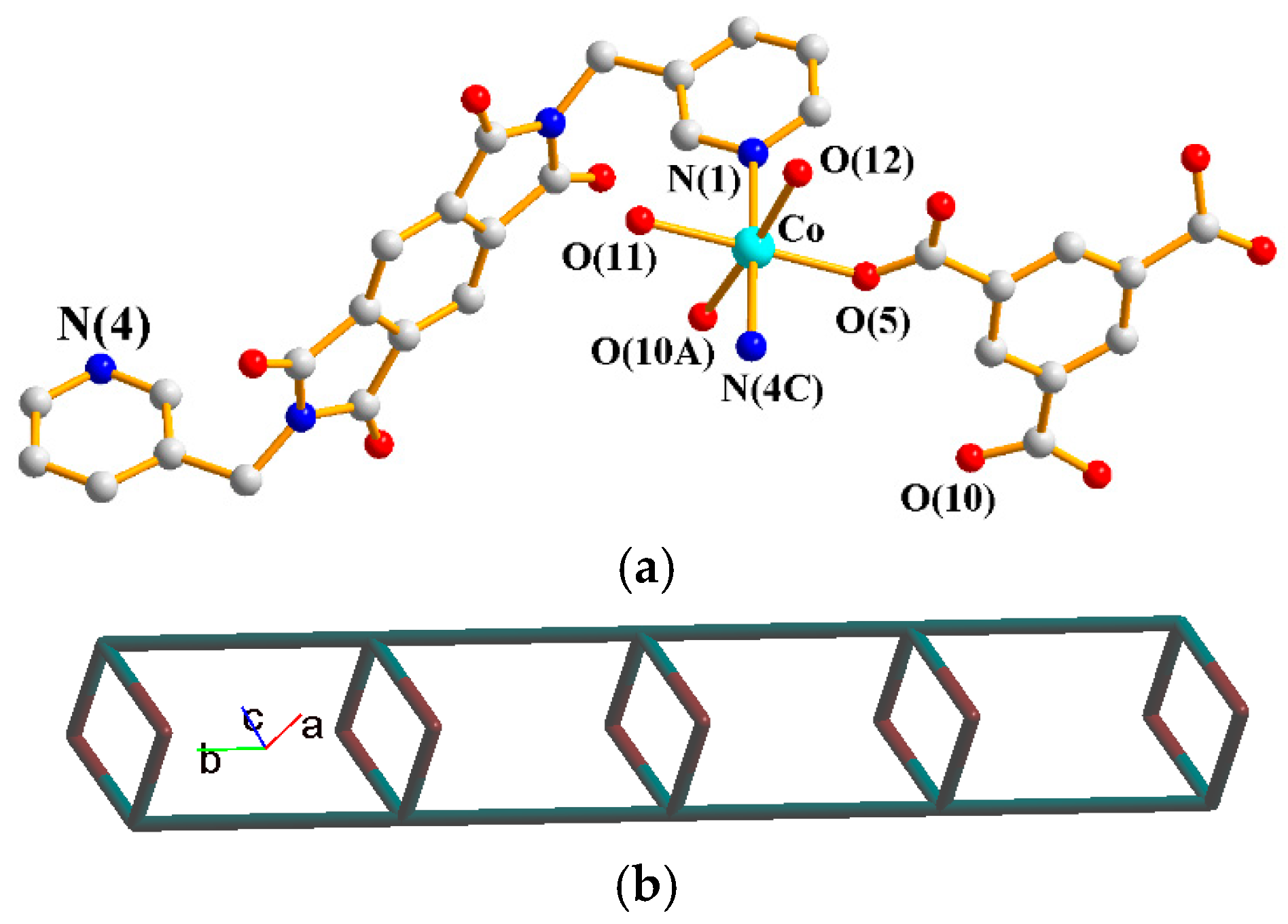

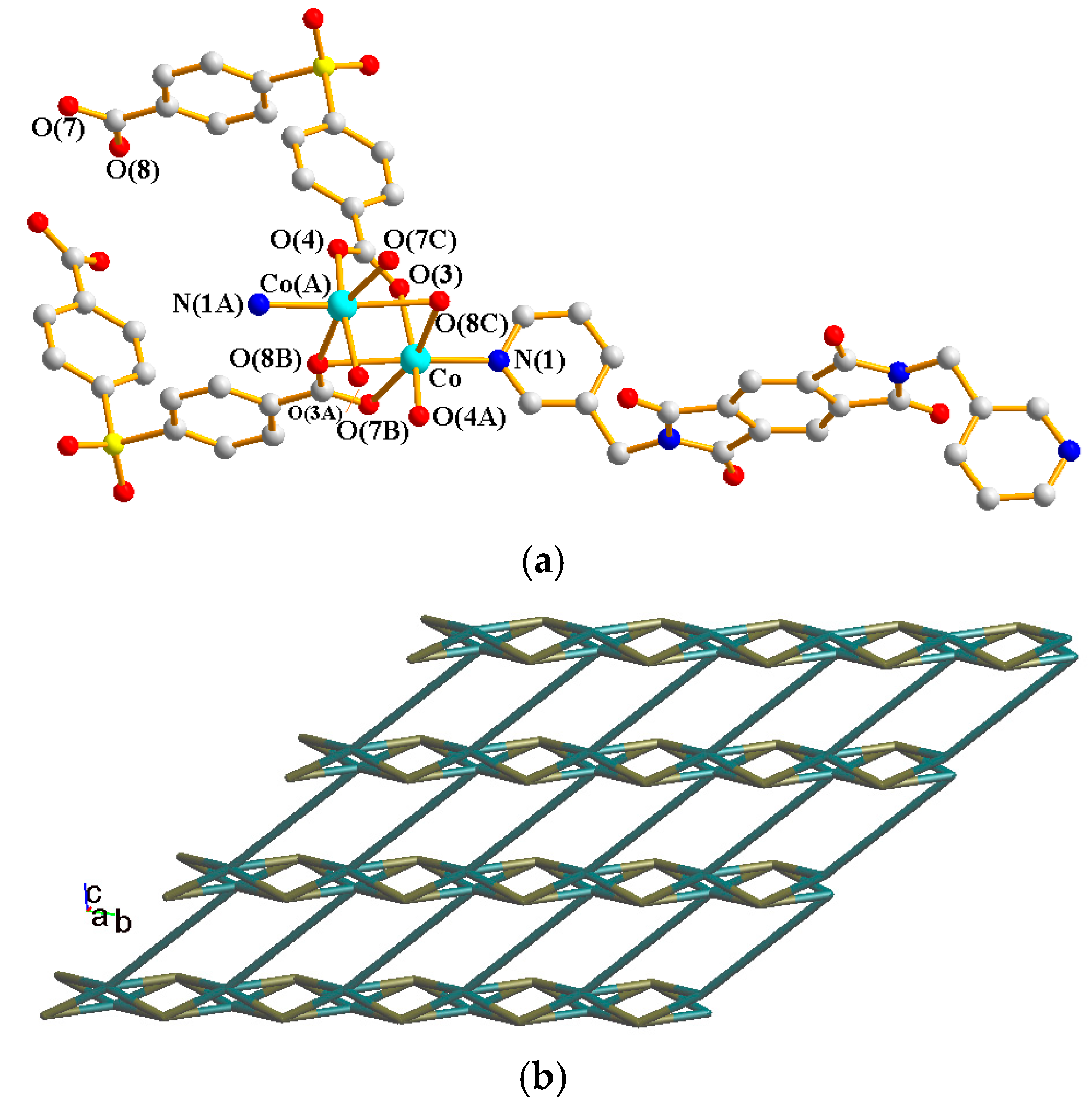
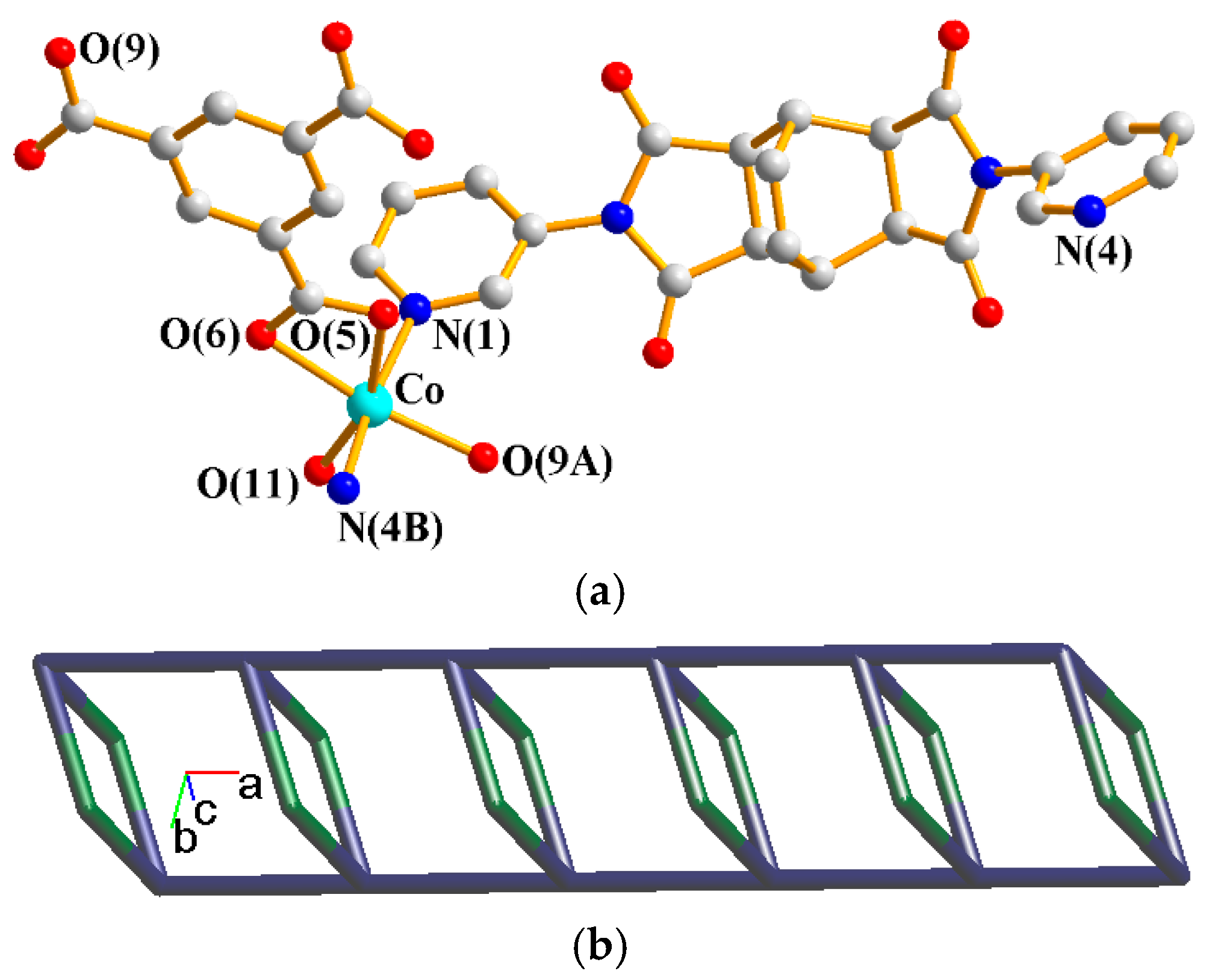
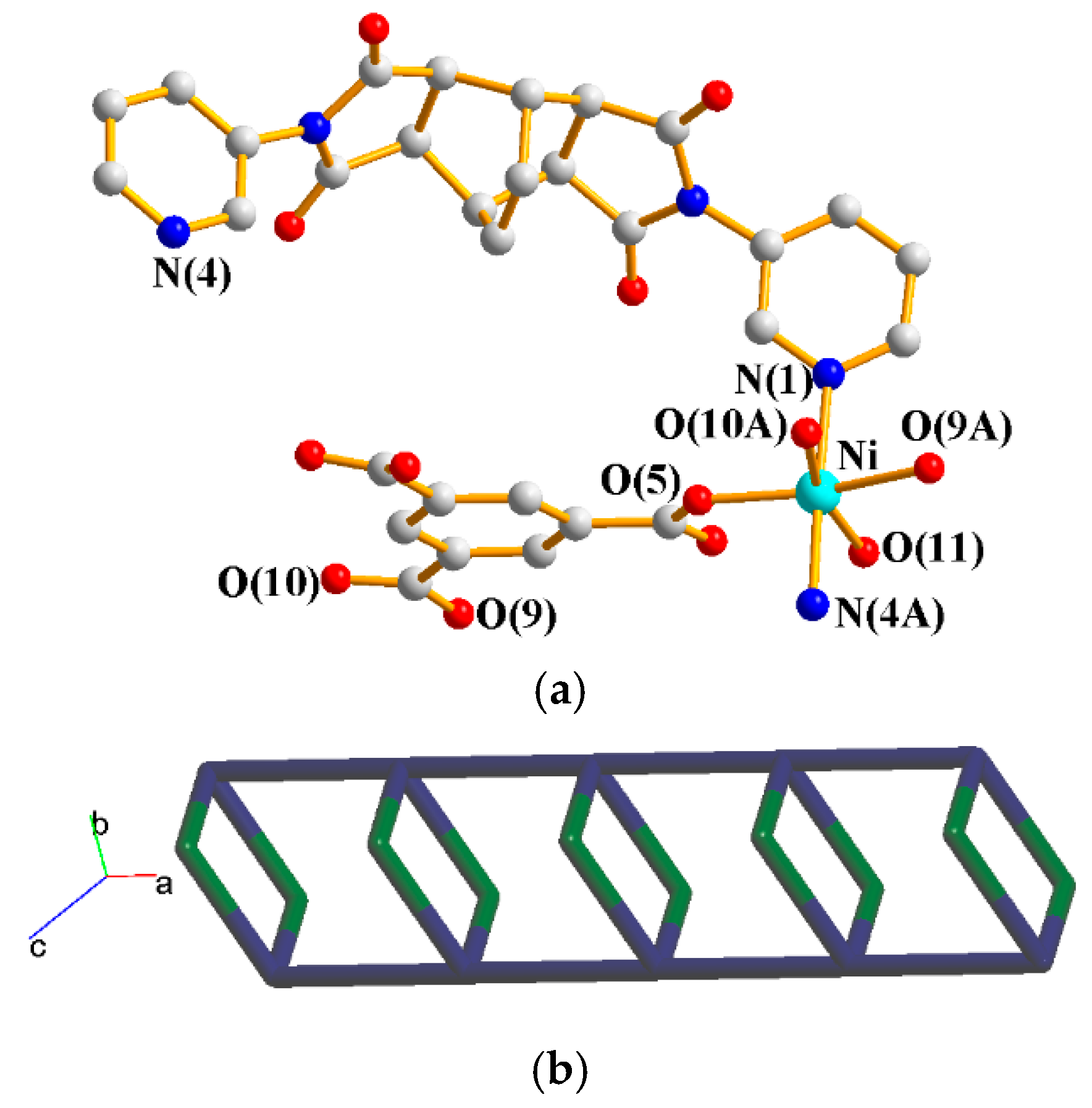
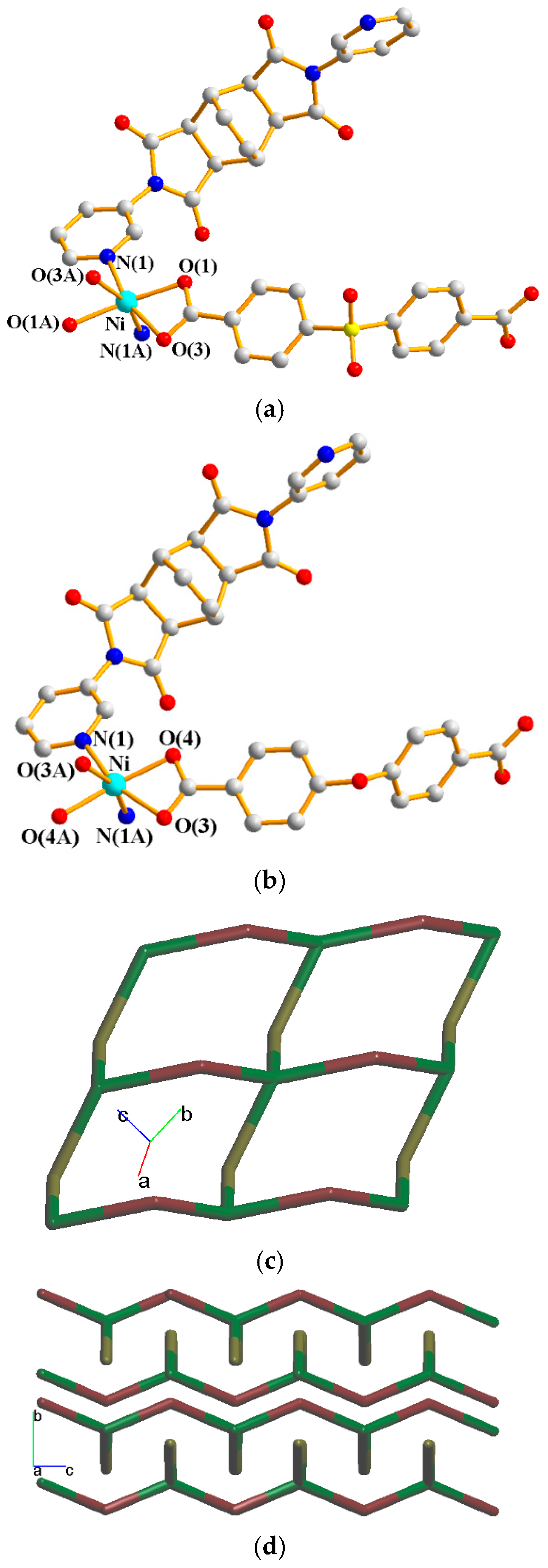
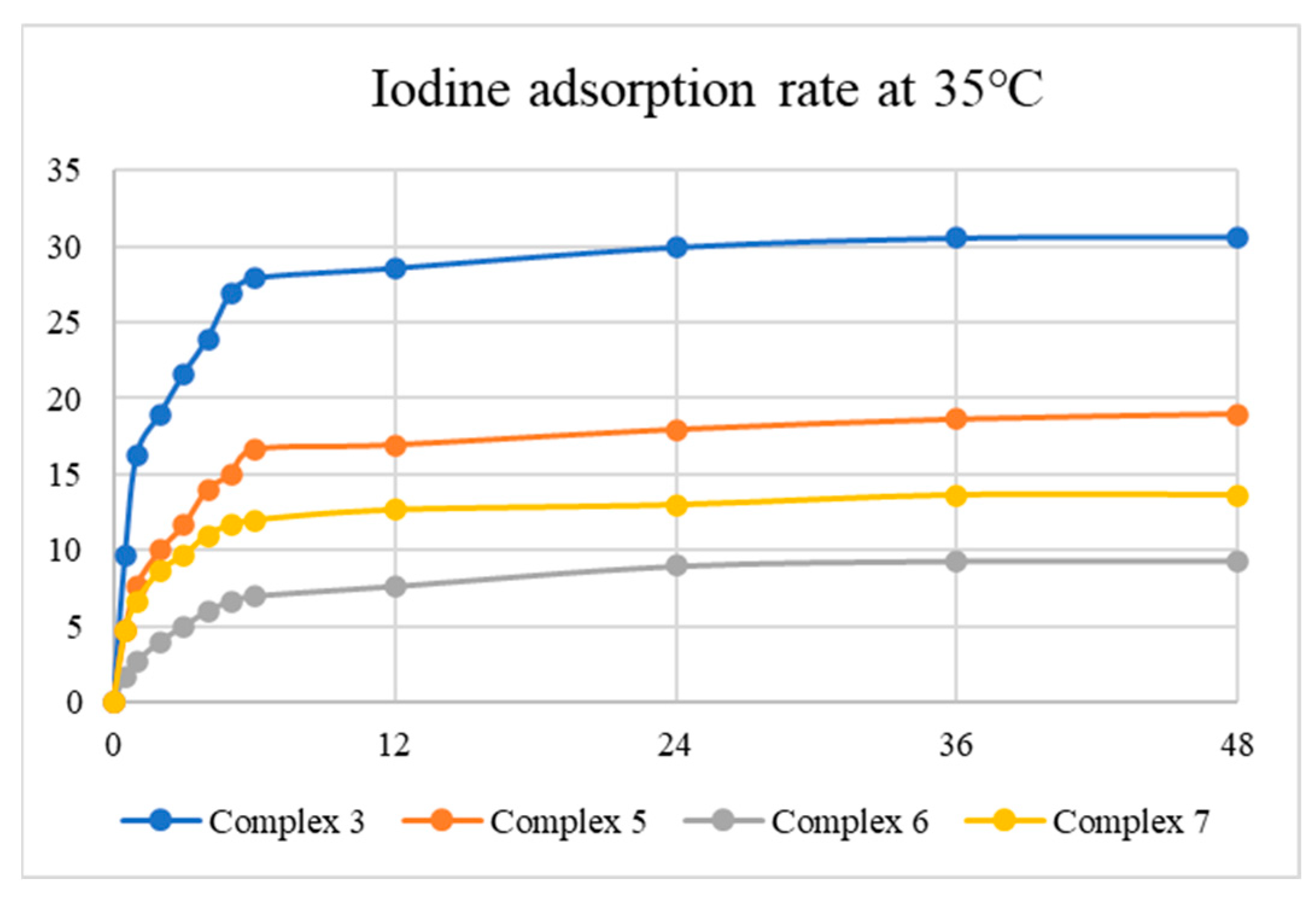
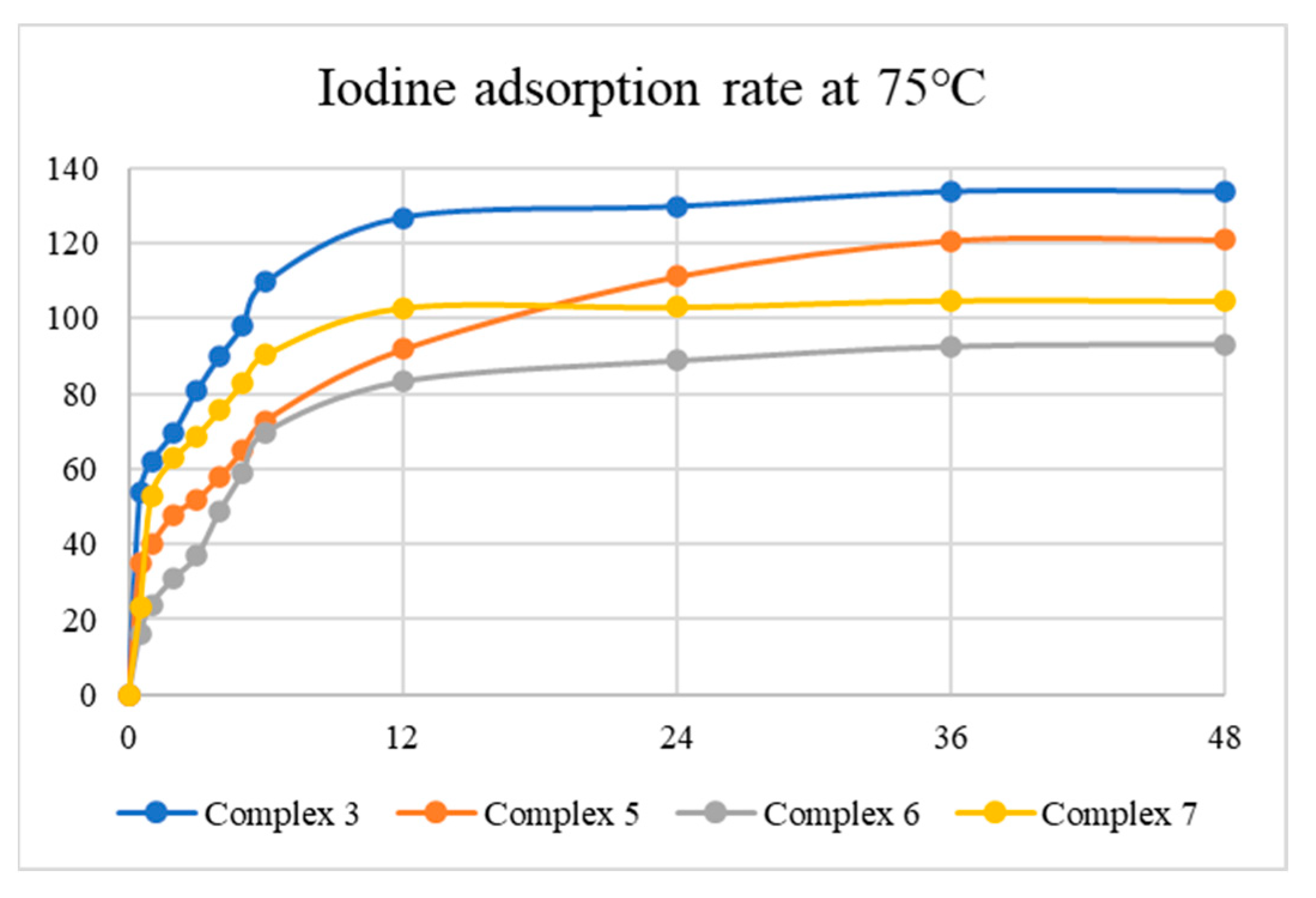
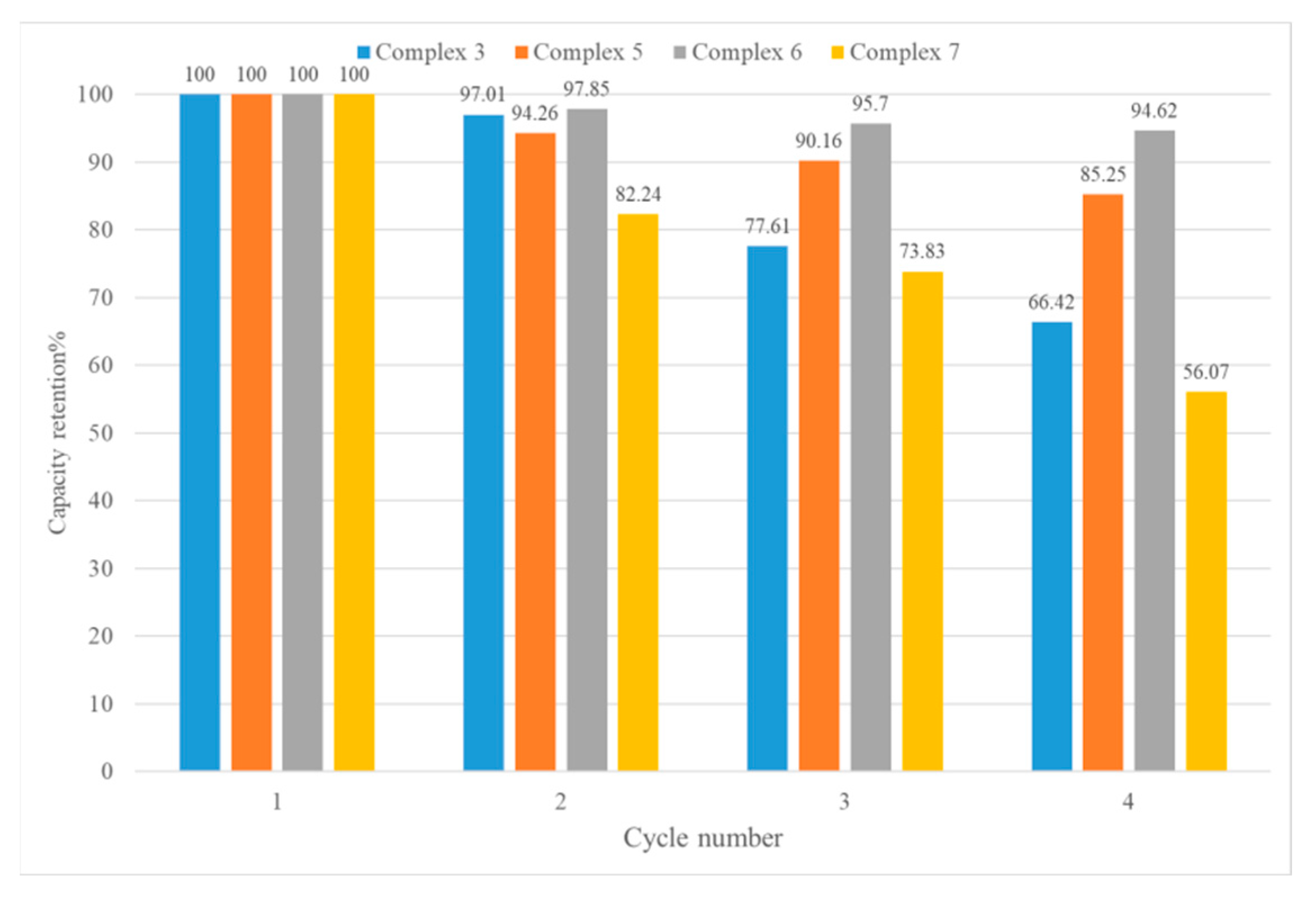
| Ligand Conformation | Coordination Mode | |
|---|---|---|
| 1 |  ZT |  μ2-κO:κO′ |
| 2 |  ZT | 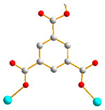 μ2-κO:κO′ |
| 3 |  ZT |  μ4-κ2O,O′:κO″:κO‴:κO″″ |
| 4 |  cis |  μ2-κ2O,O′:κO″ |
| 5 |  cis |  μ2-κ2O,O′:κO″ |
| 6 |  cis |  μ2-κ2O,O′:κ2O″,O‴ |
| 7 |  cis |  μ2-κ2O,O′:κ2O″,O‴ |
| Complex | Weight Loss of Solvent °C (Calc/Found),% | Weight Loss of Ligand °C (Calc/Found),% |
|---|---|---|
| 1 | 2 H2O 30–175 (7.50/11.01) | L1 + 1,3,5-HBTC2− 175–650 (84.31/80.24) |
| 2 | 4 H2O 30–170 (13.37/11.00) | 0.5 (L1) + 1,3,5-HBTC2− 170–540 (75.69/71.97) |
| 3 | 1 H2O 30–345 (3.10/6.66) | 0.5 (L1) + SDA2− 345–550 (86.79/83.48) |
| 4 | 2 H2O 30–230 (5.10/5.17) | L2 + 1,3,5-HBTC2− 230–540 (86.55/85.06) |
| 5 | 2 H2O 30–260 (5.11/5.23) | L2 + 1,3,5-HBC2−) 260–800 (87.83/86.55) |
| 6 | L2 + SDA2− 30–800 (92.32/91.10) | |
| 7 | L2 + OBA2− 30–600 (91.80/92.45) |
| Complex | 1 | 2 | 3 | 4 | ||
|---|---|---|---|---|---|---|
| CCDC No. | 2410834 | 2410835 | 2410836 | 2410837 | ||
| Formula | C31H24CoN4O13 | C20H19CoN2O12 | C25H17CoN2O9S | C62H52CoN8O24 | ||
| Formula weight | 719.47 | 538.30 | 580.39 | 1410.97 | ||
| Crystal system | Triclinic | Monoclinic | Triclinic | Triclinic | ||
| Space group | Pī | P21/c | Pī | Pī | ||
| a, Å | 9.156(7) | 10.8982(5) | 8.4917(9) | 10.3096(7) | ||
| b, Å | 13.754(9) | 20.3062(8) | 12.0705(12) | 11.9016(8) | ||
| c, Å | 14.239(10) | 11.0603(5) | 12.3303(13) | 12.3186(9) | ||
| α, ° | 105.32(2) | 90 | 95.326(3) | 92.5130(18) | ||
| β, ° | 105.84(2) | 119.3790(10) | 100.465(3) | 99.3631(18) | ||
| γ,° | 105.05(3) | 90 | 100.273(3) | 96.1909(16) | ||
| V, Å3 | 1553.9(19) | 2132.87(16) | 1212.6(2) | 1479.76(18) | ||
| Z | 2 | 4 | 2 | 1 | ||
| Dcalc, Mg/m3 | 1.538 | 1.676 | 1.590 | 1.583 | ||
| F(000) | 738 | 1104 | 592 | 726 | ||
| µ(Mo Kα), mm−1 | 0.100 | 0.100 | 0.100 | 0.100 | ||
| Range(2θ) for data collection, deg | 3.18 ≤ 2θ ≤ 52.00 | 4.01 ≤ 2θ ≤ 56.67 | 3.38 ≤ 2θ ≤ 51.99 | 3.35 ≤ 2θ ≤ 52.00 | ||
| Independent reflection | 6112 [R(int) = 0.0711] | 5306 [R(int) = 0.0392] | 4776 [R(int) = 0.0460] | 5833 [R(int) = 0.1011] | ||
| Data/restraint/parameter | 6112/0/442 | 5306/0/316 | 4766/0/342 | 5833/0/443 | ||
| quality-of-fit indicator c | 1.019 | 1.014 | 1.019 | 1.021 | ||
| Final R indices [I > 2σ(I)] a,b | R1 = 0.0566, wR2 = 0.1366 | R1 = 0.0376, wR2 = 0.0800 | R1 = 0.0386, wR2 = 0.0861 | R1 = 0.0615, wR2 = 0.1417 | ||
| R indices (all data) | R1 = 0.0922, wR2 = 0.1555 | R1 = 0.0659, wR2 = 0.0906 | R1 = 0.0555, wR2 = 0.0944 | R1 = 0.1293, wR2 = 0.1729 | ||
| Complex | 5 | 6 | 7 | |||
| CCDC No. | 2410838 | 2410839 | 2410840 | |||
| Formula | C31H24N4NiO12 | C36H24N4NiO10S | C36H24N4NiO9 | |||
| Formula weight | 703.25 | 763.36 | 715.30 | |||
| Crystal system | Monoclinic | Monoclinic | Monoclinic | |||
| Space group | P21/c | C2/c | C2/c | |||
| a, Å | 10.298(3) | 12.902(5) | 12.9670(7) | |||
| b, Å | 12.219(3) | 20.793(7) | 19.6947(11) | |||
| c, Å | 14.6033(2) | 13.180(4) | 12.9964(10) | |||
| α, ° | 25.655(7) | 90 | 90 | |||
| β, ° | 90 | 111.607(9) | 113.6724(12) | |||
| γ,° | 96.424(5) | 90 | 90 | |||
| V, Å3 | 90 | 3287(2) | 3039.8(3) | |||
| Z | 4 | 4 | 4 | |||
| Dcalc, Mg/m3 | 1.456 | 1.542 | 1.563 | |||
| F(000) | 1448 | 1568 | 1472 | |||
| µ(Mo Kα), mm−1 | 0.100 | 0.100 | 0.100 | |||
| Range (2θ) for data collection, deg | 3.19 ≤ 2θ ≤ 52.00 | 3.91 ≤ 2θ ≤ 52.00 | 1.00 ≤ 2θ ≤ 52.00 | |||
| Independent reflection | 6308 [R(int) =0.0532] | 3229 [R(int) = 0.0400] | 2989 [R(int) = 0.0471] | |||
| Data/restraint/parameter | 6308/0/446 | 3229/0/236 | 2989/0/243 | |||
| quality-of-fit indicator c | 1.050 | 1.026 | 1.016 | |||
| Final R indices [I > 2σ(I)] a,b | R1 = 0.0531, wR2 = 0.1486 | R1 = 0.0368, wR2 = 0.0787 | R1 = 0.0345, wR2 = 0.0659 | |||
| R indices (all data) | R1 = 0.0707, wR2 = 0.1620 | R1 = 0.0567, wR2 = 0.0858 | R1 = 0.0557, wR2 = 0.0725 | |||
Disclaimer/Publisher’s Note: The statements, opinions and data contained in all publications are solely those of the individual author(s) and contributor(s) and not of MDPI and/or the editor(s). MDPI and/or the editor(s) disclaim responsibility for any injury to people or property resulting from any ideas, methods, instructions or products referred to in the content. |
© 2025 by the authors. Licensee MDPI, Basel, Switzerland. This article is an open access article distributed under the terms and conditions of the Creative Commons Attribution (CC BY) license (https://creativecommons.org/licenses/by/4.0/).
Share and Cite
Chen, Y.-W.; Chen, Z.-L.; Wang, S.-W.; Chen, J.-D. Coordination Polymers Constructed from Polycarboxylic Acids and Semi-Rigid Bis-pyridyl-bis-imide Ligands: Synthesis, Structures and Iodine Adsorption. Inorganics 2025, 13, 69. https://doi.org/10.3390/inorganics13030069
Chen Y-W, Chen Z-L, Wang S-W, Chen J-D. Coordination Polymers Constructed from Polycarboxylic Acids and Semi-Rigid Bis-pyridyl-bis-imide Ligands: Synthesis, Structures and Iodine Adsorption. Inorganics. 2025; 13(3):69. https://doi.org/10.3390/inorganics13030069
Chicago/Turabian StyleChen, Yi-Wun, Zhi-Ling Chen, Song-Wei Wang, and Jhy-Der Chen. 2025. "Coordination Polymers Constructed from Polycarboxylic Acids and Semi-Rigid Bis-pyridyl-bis-imide Ligands: Synthesis, Structures and Iodine Adsorption" Inorganics 13, no. 3: 69. https://doi.org/10.3390/inorganics13030069
APA StyleChen, Y.-W., Chen, Z.-L., Wang, S.-W., & Chen, J.-D. (2025). Coordination Polymers Constructed from Polycarboxylic Acids and Semi-Rigid Bis-pyridyl-bis-imide Ligands: Synthesis, Structures and Iodine Adsorption. Inorganics, 13(3), 69. https://doi.org/10.3390/inorganics13030069







